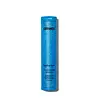What's inside
What's inside
 Key Ingredients
Key Ingredients

 Benefits
Benefits

 Concerns
Concerns

 Ingredients Side-by-side
Ingredients Side-by-side

Water
Skin ConditioningGlycerin
HumectantParfum
MaskingStearyl Alcohol
EmollientCoconut Alkanes
EmollientCocoglucosides Hydroxypropyltrimonium Chloride
CleansingCetyl Alcohol
EmollientBehentrimonium Methosulfate
Bertholletia Excelsa Seed Oil
EmollientTheobroma Grandiflorum Seed Butter
Skin ConditioningOrbignya Oleifera Seed Oil
EmollientAstrocaryum Tucuma Seed Butter
EmollientTocopherol
AntioxidantCoco-Caprylate/Caprate
EmollientLactic Acid
BufferingGardenia Jasminoides Fruit Extract
Cosmetic ColorantHydrolyzed Gardenia Florida Extract
AntioxidantButylene Glycol
HumectantMaltodextrin
AbsorbentPhenoxyethanol
PreservativeIsohexadecane
EmollientSodium Hydroxide
BufferingLimonene
PerfumingBenzyl Alcohol
PerfumingCoumarin
PerfumingBenzyl Salicylate
PerfumingHydroxycitronellal
PerfumingWater, Glycerin, Parfum, Stearyl Alcohol, Coconut Alkanes, Cocoglucosides Hydroxypropyltrimonium Chloride, Cetyl Alcohol, Behentrimonium Methosulfate, Bertholletia Excelsa Seed Oil, Theobroma Grandiflorum Seed Butter, Orbignya Oleifera Seed Oil, Astrocaryum Tucuma Seed Butter, Tocopherol, Coco-Caprylate/Caprate, Lactic Acid, Gardenia Jasminoides Fruit Extract, Hydrolyzed Gardenia Florida Extract, Butylene Glycol, Maltodextrin, Phenoxyethanol, Isohexadecane, Sodium Hydroxide, Limonene, Benzyl Alcohol, Coumarin, Benzyl Salicylate, Hydroxycitronellal
Water
Skin ConditioningSodium Cocoyl Isethionate
CleansingCocamidopropyl Hydroxysultaine
CleansingCoco-Glucoside
CleansingGlycol Distearate
EmollientSqualane
EmollientHippophae Rhamnoides Fruit/Seed Oil
AntimicrobialBrassica Campestris Seed Oil
Skin ConditioningSesamum Indicum Seed Oil
EmollientCocos Nucifera Oil
MaskingSodium Hyaluronate
HumectantPolyglutamic Acid
Skin ConditioningSpirulina Platensis Extract
Skin ProtectingCocos Nucifera Water
MaskingEmblica Officinalis Fruit Extract
Skin ConditioningCurcuma Longa Root Extract
MaskingLeuconostoc/Radish Root Ferment Filtrate
AntimicrobialCocamide Mipa
EmulsifyingCoconut Acid
CleansingPolyester-11
Skin ConditioningGuar Hydroxypropyltrimonium Chloride
Skin ConditioningPolyquaternium-7
Polyquaternium-73
Sodium Methyl Cocoyl Taurate
CleansingTetrasodium Glutamate Diacetate
Sodium Benzoate
MaskingSodium Isethionate
CleansingSodium Hydroxide
BufferingSodium Chloride
MaskingCitric Acid
BufferingPotassium Sorbate
PreservativePhenoxyethanol
PreservativeParfum
MaskingBenzyl Benzoate
AntimicrobialHydroxycitronellal
PerfumingLimonene
PerfumingWater, Sodium Cocoyl Isethionate, Cocamidopropyl Hydroxysultaine, Coco-Glucoside, Glycol Distearate, Squalane, Hippophae Rhamnoides Fruit/Seed Oil, Brassica Campestris Seed Oil, Sesamum Indicum Seed Oil, Cocos Nucifera Oil, Sodium Hyaluronate, Polyglutamic Acid, Spirulina Platensis Extract, Cocos Nucifera Water, Emblica Officinalis Fruit Extract, Curcuma Longa Root Extract, Leuconostoc/Radish Root Ferment Filtrate, Cocamide Mipa, Coconut Acid, Polyester-11, Guar Hydroxypropyltrimonium Chloride, Polyquaternium-7, Polyquaternium-73, Sodium Methyl Cocoyl Taurate, Tetrasodium Glutamate Diacetate, Sodium Benzoate, Sodium Isethionate, Sodium Hydroxide, Sodium Chloride, Citric Acid, Potassium Sorbate, Phenoxyethanol, Parfum, Benzyl Benzoate, Hydroxycitronellal, Limonene
 Reviews
Reviews

Ingredients Explained
These ingredients are found in both products.
Ingredients higher up in an ingredient list are typically present in a larger amount.
Hydroxycitronellal is a fragrance created from citronellal. The smell of hydroxycitronellal is often described as "citrus-like" or "melon-like".
Hydroxycitronellal is a known EU allergen and may cause irritation when applied to the skin.
Limonene is a fragrance that adds scent and taste to a formulation.
It's found in the peel oil of citrus fruits and other plants such as lavender and eucalyptus. The scent of limonene is generally described as "sweet citrus".
Limonene acts as an antioxidant, meaning it helps neutralize free radicals.
When exposed to air, oxidized limonene may sensitize the skin. Because of this, limonene is often avoided by people with sensitive skin.
The term 'fragrance' is not regulated in many countries. In many cases, it is up to the brand to define this term. For instance, many brands choose to label themselves as "fragrance-free" because they are not using synthetic fragrances. However, their products may still contain ingredients such as essential oils that are considered a fragrance.
Learn more about LimoneneParfum is a catch-all term for an ingredient or more that is used to give a scent to products.
Also called "fragrance", this ingredient can be a blend of hundreds of chemicals or plant oils. This means every product with "fragrance" or "parfum" in the ingredients list is a different mixture.
For instance, Habanolide is a proprietary trade name for a specific aroma chemical. When used as a fragrance ingredient in cosmetics, most aroma chemicals fall under the broad labeling category of “FRAGRANCE” or “PARFUM” according to EU and US regulations.
The term 'parfum' or 'fragrance' is not regulated in many countries. In many cases, it is up to the brand to define this term.
For instance, many brands choose to label themselves as "fragrance-free" because they are not using synthetic fragrances. However, their products may still contain ingredients such as essential oils that are considered a fragrance by INCI standards.
One example is Calendula flower extract. Calendula is an essential oil that still imparts a scent or 'fragrance'.
Depending on the blend, the ingredients in the mixture can cause allergies and sensitivities on the skin. Some ingredients that are known EU allergens include linalool and citronellol.
Parfum can also be used to mask or cover an unpleasant scent.
The bottom line is: not all fragrances/parfum/ingredients are created equally. If you are worried about fragrances, we recommend taking a closer look at an ingredient. And of course, we always recommend speaking with a professional.
Learn more about ParfumPhenoxyethanol is a preservative that has germicide, antimicrobial, and aromatic properties. Studies show that phenoxyethanol can prevent microbial growth. By itself, it has a scent that is similar to that of a rose.
It's often used in formulations along with Caprylyl Glycol to preserve the shelf life of products.
Sodium Hydroxide is also known as lye or caustic soda. It is used to adjust the pH of products; many ingredients require a specific pH to be effective.
In small amounts, sodium hydroxide is considered safe to use. However, large amounts may cause chemical burns due to its high alkaline.
Your skin has a natural pH and acid mantle. This acid mantle helps prevent harmful bacteria from breaking through. The acid mantle also helps keep your skin hydrated.
"Alkaline" refers to a high pH level. A low pH level would be considered acidic.
Learn more about Sodium HydroxideWater. It's the most common cosmetic ingredient of all. You'll usually see it at the top of ingredient lists, meaning that it makes up the largest part of the product.
So why is it so popular? Water most often acts as a solvent - this means that it helps dissolve other ingredients into the formulation.
You'll also recognize water as that liquid we all need to stay alive. If you see this, drink a glass of water. Stay hydrated!
Learn more about Water